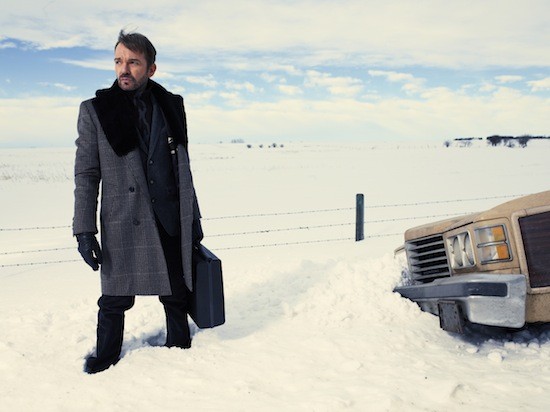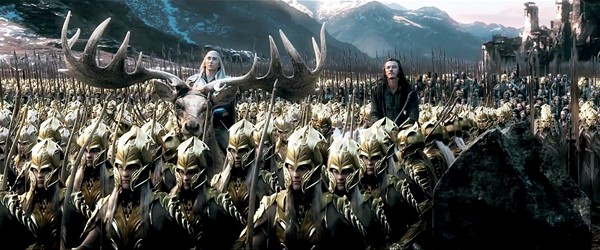Cumberbitches rejoice: Your hero has returned. Sherlock, BBC One’s brilliant modern take on the continuing adventures of the world’s greatest detective, begins its third season Sunday night on PBS. Its welcome reappearance during a stretch of the calendar year when many movie studios are busy dumping their least appealing product on an unsuspecting public (see The Legend of Hercules — or, actually, don’t) is great news indeed.
Like the basic-cable dramas Justified and Breaking Bad, Sherlock‘s long story arcs and high level of craftsmanship tend to blur the line between television and cinema. Each 90-minute episode is remarkable not only for its breakneck pace but also for its striking and playful use of film technique. In fact, when compared to Christopher Nolan’s Dark Knight trilogy, Sherlock offers a faster, smarter take on the crimefighter-criminal dynamic. And the TV show is even more perceptive about the psychology of an iconic hero who may be on the side of the angels but definitely isn’t one of them.
The terrifically exciting Series 2 finale, “The Reichenbach Fall,” aired on U.S. television in May 2012, and in the meantime, Sherlock’s two leads have gotten pretty famous. Benedict Cumberbatch, who plays Sherlock Holmes, and Martin Freeman, who plays Dr. John Watson, are big-time Hollywood stars now. Last year, Cumberbatch appeared in everything from Star Trek Into Darkness to 12 Years A Slave, while Freeman has starred as young Bilbo Baggins in the first two installments of Peter Jackson’s Hobbit trilogy. They’ve worked together once since Sherlock, in The Hobbit: The Desolation of Smaug in which Cumberbatch is the voice of the dragon.
I get the sense that Freeman and Cumberbatch returned to the small screen because these current incarnations of Holmes and Watson are too richly imagined to give to anyone else. No previous Sherlock I know of has gloried in his own brilliance more smugly or swung a scarf around his neck more stylishly than Cumberbatch, whose alien handsomeness reinforces his status on the show as a hyper-observant outer space being. And few Watsons have conveyed the complex nature of a friendship with Sherlock Holmes with more low-key humor or well-earned pathos than Freeman, whose grief in the new season’s premiere episode, “The Empty Hearse,” is as serious as his mustache is stupid-looking.
The sly sense of humor that occasionally surfaced throughout Series 1 and 2 is more prominent in the first two episodes of Series 3. Although there are suspenseful moments in both “The Empty Hearse” and “The Sign of Three,” this year’s Sherlock episodes are noticeably lighter in tone. The new emphasis on humor feels logical and necessary after the nerve-jangling suspense of “A Study in Pink,” “The Great Game,” and the rest of the Moriarty arc in Series 2.
Besides, the way Sherlock handles the drudgeries of daily life are as fascinating and pleasurable as the way he solves crimes. The questions posed to him by everyday existence are, if anything, more perplexing than well-dressed skeletons or unsolved murders. How does a high-functioning sociopath like him express vulnerability when every conversation becomes an interrogation and a power struggle? How would such a remorselessly logical individual plan a pub crawl? How might someone with (at best) a theoretical understanding of human emotion deliver a heartfelt best-man speech at his best friend’s wedding?
Sherlock‘s wit and insouciance are also reflected in the series’ playful handling of the Holmes mythology. The title of the premiere, “The Empty Hearse,” refers to “The Adventure of the Empty House,” Sir Arthur Conan Doyle’s original back-from-the-dead Holmes adventure; Sherlock’s own facility with disguise there and elsewhere is frequently rendered both remarkable and ridiculous. Every episode throws in a couple of sly nods to major and minor cases from the Holmes dossier as well.
In addition, Sherlock‘s memorable imagery and flamboyant editing frequently surpass much of what’s playing on bigger screens. Sherlock directors Paul McGuigan, Euros Lyn, Toby Haynes, Jeremy Lovering, and Colm McCarthy are all particularly adept at dramatizing the use of computers and other technologies: text messages float into the air and sometimes swarm into clouds of words and information on screen. One of the most innovative scenes in Sherlock occurs during the McCarthy-helmed “The Sign of Three,” when Holmes arranges a batch of laptops to identify a “ghost man” connected to a handful of seemingly random women. The cuts between Sherlock in cyberspace and Sherlock at 221B Baker Street are, like him, clever enough to elicit headshakes and grins.
But the show’s most impressive technical accomplishment lies in the way it visualizes Holmes’ quick-twitch deductive powers. His observations are often conveyed through lightning-fast montages that zero in on important physical details and label them, so you can (for a moment, anyway) notice the visible tan line and bit of foreign currency jammed in a shady used-car dealer’s wallet or peg a Buckingham palace official as a public-school graduate who rides horses and loves dogs.
Speaking of Buckingham Palace, it’s important to remember that Sherlock Holmes’ fame as a “consulting detective” thrives in part because of the tacit approval of both Scotland Yard and his older brother Mycroft (Sherlock co-creator Mark Gatiss), who works for the British government. In previous episodes, Mycroft has come off as a supercilious meddler. But in “The Empty Hearse,” Mycroft’s formidable deductive skills are highlighted during some bantering one-upmanship with his younger sibling over a knitted cap. This relatively minor scene between Cumberbatch and Gatiss is a Series 3 highlight.
Wit and technical wizardry aside, the new series should draw a large audience because Sherlocked fans everywhere want to know how their hero faked his own death. I wouldn’t dream of spoiling the big reveal in “The Empty Hearse,” although I was delighted by the ways in which Gatiss and co-writers Steven Moffat and Stephen Thompson poke fun at the numerous theories that tried to explain how Sherlock survived his apparent suicide. But, having recently rewatched “The Reichenbach Fall” with fair play in mind, I can confirm that Holmes’ alibi and rationale check out. If they don’t satisfy you, then, as Sherlock himself sneers, “Everybody’s a critic.”
Sherlock, Series 3 (Masterpiece Mystery!)
Beginning Sunday, January 19th, 9 p.m.
PBS (WKNO, Channel 10 in Memphis)

